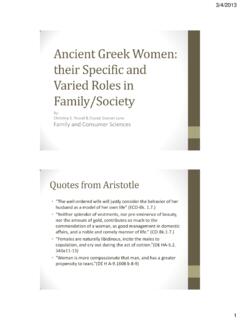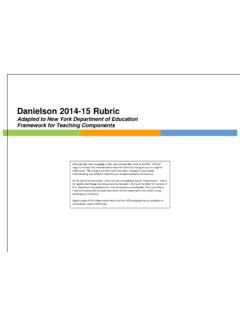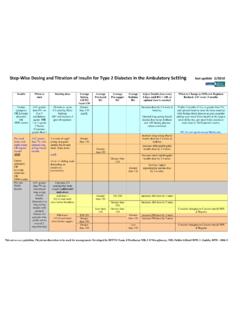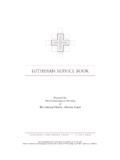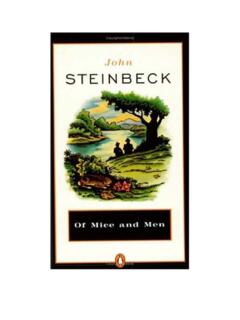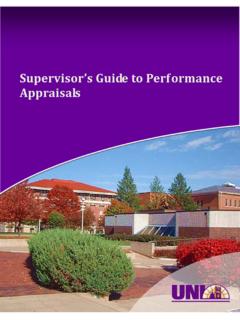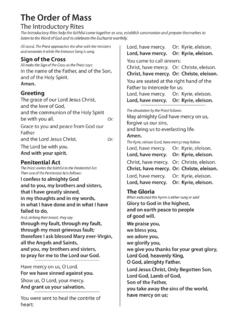Transcription of Medieval Games and Recreation - EIU
1 Medieval Games and Recreation Games Played in the Middle Ages (Outdoor entertainment during the middle ages centered around the Village Green.) Games of Amusement Hide n Seek Hide and Seek was played the same as today. Using whatever hiding places are available and the restrictions or limits agreed on by the players, play this ancient child's game. Someone is designated at it. Everyone hides. It looks for them. Usually, the first one found is it the next round although there are many variations. Tag Tag is another game played the same. Tapestry's, murals, and other drawings and pictures show kids chasing each other in what appears to be tag.
2 Set up the game your favorite way, or ask the kids for their favorite version. There are literally hundreds of versions of tag. Nevertheless, at its essence, whoever is designated as it chases the other players until they successfully tag another player. That player is then it for the next round. Many versions have a safe place where runners can rest and untaggable base . Ring Around the Rosie The words to the Ring Around the Rosy have their origin in English history. The historical period dates back to the Great Plague of London in 1665 (bubonic plague) or even before when the first outbreak of the Plague hit England in the 1300's.
3 The symptoms of the plague included a rosy red rash in the shape of a ring on the skin (Ring around the rosy). Pockets and pouches were filled with sweet smelling herbs (or posies) which were carried due to the belief that the disease was transmitted by bad smells. The term "ashes, ashes" refers to the cremation of the dead bodies! The death rate was over 60% and the Great Fire of London only halted the plague in 1666, which killed the rats, which carried the disease, which was transmitting, via water sources. The English version of "Ring around the rosy" replaces Ashes with (A-tishoo, A-tishoo) as violent sneezing was another symptom of the disease.
4 Players hold hands in the shape of a circle. While they walk in a circle, they sing or Ring around the rosy A pocketful of posies "Ashes, Ashes" We all fall down! See Saw See saw is essentially two people going up and down on opposite ends of a board with a fixed object in the middle allowing one side to be up while the other is down. The two players are seated and use their legs to propel themselves back up while the other player goes back down. It can be as simple of a version as a board over a barrel or tree log. Walking on Stilts In Medieval times, many of the Games children played mimicked what they saw at festivals or what they observed in battle training.
5 Games helped them practice accuracy, agility, balance, and strategy. Walking on stilts would have been something they observed acrobats and other performers doing at Medieval Faires. Swimming Children of every time period enjoy swimming. Not only was it a way to cool down in a time without air conditioning, but also a fun and relaxing way to clean up the day s work. Fishing Fishing can be fun and relaxing. It might also produce a tasty dish for supper. Prisoner s Base This English game of chase and tag that was banned in the 1300s by King Edward III.
6 Before the twentieth century, the game was known as "Chevy Chase" or "Chivy." Object of the Game: The team with the most prisoners at the end of the time limit wins. You will need: A minimum of ten players A stick or chalk Large playing area How to play: The group needs divided in half and a line of chalk was placed down the middle between the two teams. About 20-30 feet behind each team a large square (prison) was drawn on the ground using chalk. Each team picked one person to be the prisoner of the other team (usually someone who could run fast).
7 Then each team would try to free their prisoner by sending a team member to the prison through the opposing team to bring him/her back without being captured by a member of the opposing team. If the person attempting to rescue their own prisoner made in to the prison through the opposing team without being caught, he/she was safe while in the prison and could pick their own time to run with the prisoner back to their own side of the line. If the team member was caught by the opposing team, they also became a prisoner needing rescue. So each team was busy both trying to rescue their own prisoners and protect the prisoner(s) from the opposite side from being rescued.
8 At the end of time, the team with the most prisoners won. Hopscotch Hopscotch dates back to the Roman occupation of Britain. The first thing to be done is to draw a course, several common court styles are seen below. Each player then chooses a marker, usually a stone. Play begins with the first player tossing his stone into the first space. If the stone lands completely within the designated square, the player proceeds to hop through the course. A player can only have one foot in any given square, so single squares must be balanced and double squares (side by side) are straddled.
9 While hopping, the player should alternate the foot he lands on for each square. Any space not marked with a number, London, Home, etc., are considered rest squares and can be landed in any fashion. When the player reaches the top of the court, he then turns around and comes back, collecting his marker along the way. Play then continues with the player tossing his marker into the second square and so on. If a player fails to toss his marker into the correct square or if it touches a line the players turn ends. The same is true if the player steps on a line, misses a square, or loses his balance and falls.
10 The first player to complete the course for each numbered square wins. How many miles to London? This game begins with It being blindfolded. The other players then stand in a line and ask It for directions. It tells them how many steps to take forward backward, left, or right they must go. Then It is led to the starting point and must follow his own directions. When It has reached the final destination, he must try to touch another player. The other players may duck or sway to avoid being touched, but they cannot move their feet. If a player is tagged, then he is the next It otherwise It must try again.
